#Carolyn Kormann
Explore tagged Tumblr posts
Text
Why Maui Burned
Lahaina’s wildfire was the deadliest in the U.S. in more than a century. Now the community is grappling with the botched response as it tries to rebuild.
— By Carolyn Kormann | October 30, 2023

The Lahaina fire reached temperatures more than a thousand degrees hotter than the temperature on Venus. Photographs by Bryan Anselm/Redux for The New Yorker
At 4 P.M. On August 8th, Shaun Saribay’s family begged him to get in their car and leave the town of Lahaina, on the Hawaiian island of Maui. The wind was howling, and large clouds of smoke were approaching from the dry hills above the neighborhood. But Saribay—a tattooist, a contractor, and a landlord, who goes by the nickname Buge—told his family that he was staying to guard their house, which had been in the family for generations. “This thing just gonna pass that way, downwind,” Saribay said. At 4:05 p.m., one of his daughters texted from the car, “Daddy please be safe.”
Within ten minutes, it became clear that the fire had not passed downwind. Instead, towering flames were galloping toward Saribay’s house. He got in his truck and drove to Front Street—Lahaina’s historic waterfront drag—and found gridlock traffic. Saribay, a stocky forty-two-year-old man with a tattoo covering the left side o f his face, texted his daughters. “Don’t worry. Dad’s coming,” he wrote. Then he lost cell service. At 4:41 p.m., he pulled into the one large open space he could find, a parking lot behind the Lahaina United Methodist Church, which had just started to burn.
Saribay had recently built a closet at the church, so he knew where all the water spigots were. He filled buckets and water bottles and scrambled to find neighbors’ garden hoses. With the help of three other men who had retreated to the lot, he soaked the church, again and again, fighting a three-story ball of fire with the equivalent of a water gun. At times, the men were stomping, even peeing, on sparking debris. Saribay recorded a video for his kids: “It’s bad. All around—crazy,” he said, panning the hellscape behind him. “Remember what Dad said, eh? I’ll come back.” Almost as if to reassure himself, he added, softly, “I know you guys safe.”
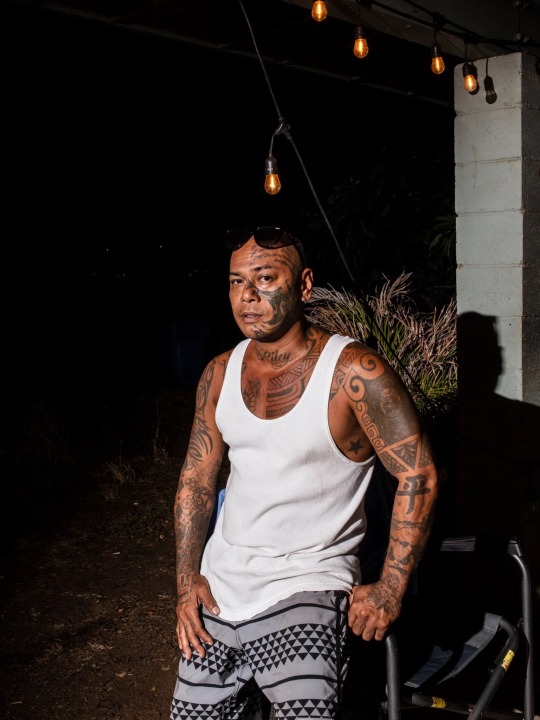
Shaun (Buge) Saribay, a tattooist and landlord, lost three houses, his tattoo parlor, and his boat in the fire. He has become a hero in the community, after he helped keep the neighborhood of Leiali‘i from burning down.
Saribay recorded videos throughout the night as he fought the fire. Despite his efforts, flames consumed the church. Well after midnight, the men tried to save a neighboring preschool, but that caught fire, too. When the sun rose and the wind began to ebb, Saribay got on an old bike and rode around town looking for other survivors. “I’m seeing fucking bodies every fucking way,” he recalled. “I’m pedalling through charcoal bodies and bodies that didn’t have one speck of burn—they just died from inhalation of black smoke. I felt like I was the only fucking human on earth.”
The Wildfire in Lahaina Was The Deadliest in the United States in more than a century. Ninety-nine people have been confirmed deceased, although for weeks the death toll was thought to be even higher, with police reporting that more than a hundred bodies had been recovered. In a town of nearly thirteen thousand people, at least seventy-two hundred were displaced. Twenty-two hundred structures were damaged or destroyed, and the estimated cost to rebuild is five and a half billion dollars. “I have been to most major disasters in the United States in the past decade. This is unprecedented,” Brad Kieserman, a senior official with the American Red Cross, said. “The speed of the fire, the level of fatality and physical destruction, the level of trauma to those who survived—it’s unspeakable.”
The destruction may have been unprecedented, but the fire itself was not. Public-safety officials, scientists, and activists had warned for years of the wildfire risks in Maui, owing to the growing population and the dryness of the island. “It was a ticking time bomb,” Willy Carter, a conservationist who studies native Hawaiian ecosystems, said. “The bomb went off.” Weeks before the disaster, conditions in parts of the state had been categorized as “severe drought,” and on August 4th the National Weather Service warned of hazardous fire conditions in the coming days. With a high-pressure system north of Hawaii and Hurricane Dora spinning hundreds of miles to the south, forecasters predicted that strong winds would be blowing, allowing flames to spread fast.
At 12:22 a.m. on August 8th, a brush fire ignited in Olinda, in the mountains of Central Maui, prompting evacuations. At 6:37 a.m., thirty-six miles away, another brush fire ignited, in a bone-dry field bordering Lahaina Intermediate School. Hard winds had toppled utility poles, and flying sparks from downed power lines likely started the blaze. (The official cause is still under investigation, according to the Maui Fire Department.) Nearby residents were ordered to evacuate within three minutes. By 10 a.m., the county announced, via Facebook, that the Lahaina fire was “100% contained,” but that a main road was closed.
Around 3 p.m., people noticed smoke clouding the sky near the school. With the wind gusting more than seventy miles per hour, the fire had flared up again in the same area. During the next hour, the fire hit “crossover��—a term used to describe a moment when the relative humidity drops below the temperature in Celsius. This allowed the blaze to tumble freely and grow exponentially faster, exceeding firefighters’ capabilities. All they could do was try to save lives.
It would be difficult to overstate the horror of these hours, the disorientation of the hazy twilight caused by toxic smoke, the searing wind and glowing ash, the stark terror of being surrounded by tall flames, the suffocation. At various times, Maui police, in coördination with the power company, closed most of the roads out of town, because of tangles of downed lines and branches, but also because of a fear that some of those roads would direct people into the fire. Evacuees were herded onto Front Street, where traffic was at a standstill. Some people abandoned their vehicles and hurled themselves into the ocean. The water’s surface itself seemed to be smoking, making it hard to breathe. One group held on to wreckage that had fallen in the water; others waded for hours, trying to dodge or douse the embers falling on their heads.
By 7 p.m., the docks and boats in the harbor were lit up as if in a coal-fired oven, the roar of the flames broken by a staccato of exploding propane tanks. In the ocean, the current was pulling weaker swimmers out to sea. Coast Guard boats were crisscrossing the water, barely able to see through the smoke. They ultimately rescued seventeen people from the water and forty from the shore, and recovered one body the next day.
During the fire, the county’s command-and-communication system fell apart. The county sent one emergency cell-phone evacuation alert at 4:16 p.m., after the fire was already moving through town, but the order was just for a single neighborhood. At 6:03 p.m., while the fire was incinerating Front Street, and while people were struggling in the sea, Maui County’s mayor, Richard Bissen, appeared on a local news broadcast, calmly sitting in his office on the other side of the island. “I’m happy to report that the road is open to and from Lahaina,” he said, seemingly unaware of the inferno under way. The county did not issue online evacuation orders for other parts of town until 9:45 p.m. The winds finally subsided at dawn.
Maui Was Formed By Two Shield Volcanoes about two million years ago, becoming the second-largest island in the Hawaiian archipelago, the most remote chain of inhabited islands on earth. Lahaina, which means “cruel sun,” sits on the leeward side of Maui, below the western mountains, Mauna Kahālāwai, which roughly translates to “house of water.” The highest peak is one of the wettest places in the world, historically receiving about three hundred and sixty-six inches of rain per year.
Hawaiians built their communities around the watershed. Their word for water, wai, has many meanings: blood, passion, life. Lahaina—even though it was relatively hot and dry—became, because of its water supply, a cornucopia, replete with irrigated breadfruit, banana, and sugarcane crops, terraced taro patches, and fishponds. In the early nineteenth century, Lahaina was the capital of the Hawaiian Kingdom. The king lived in a coral-block palace on an island in the middle of a pond. Residents could paddle around town.
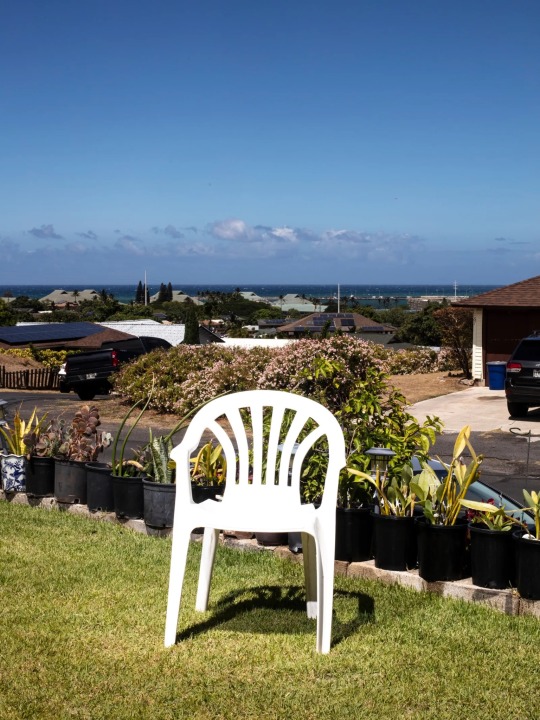
Alfredo Galinato, a seventy-nine-year-old Filipino immigrant, died in the fire. He once worked as a groundsman at the Westin and loved taking care of the hotel’s parrots.

Two of Galinato’s sons, James (left) and John (right), and his wife, Virginia.
During the American Civil War, the agricultural economy that sustained Southern farmers collapsed, and Hawaii became a primary source of sugar. But sugarcane is a thirsty crop. One ton of sugar requires a million gallons of water. To meet that demand, private companies producing sugar (and, later, pineapples) rerouted the flow from Maui’s watersheds, building concrete ditches, tunnels, pipes, flumes, siphons, and trestles across the island. European ranchers introduced non-native, drought-resistant African grasses—guinea, molasses, and buffel—for grazing livestock. In less than five decades, the island’s landscape and ecology were dramatically altered.
Agriculture declined in the late twentieth century, and plantation owners abandoned vast swaths of farmland, allowing the non-native grasses to proliferate. Instead of restoring the steep mountain streams, they left their diversions in place—in some cases, dumping water into dry gulches, or directly into the ocean—or used them to develop beachfront resorts, with lush gardens, swimming pools, and golf courses. By 1996, as Carol Wilcox writes in her chronicle “Sugar Water,” “competition for water had met the limits of the resource in Lahaina.” That same year, the newly formed West Maui Land Company started buying abandoned plantations (and their valuable irrigation systems) and creating new subdivisions.
Natural wildfire on Maui used to be rare. The high-elevation endemic forest acted like a sponge—capturing fog and rain, recharging aquifers, and releasing water downstream. But land development and the encroachment of invasive species are shrinking this ecosystem. “Towns are now, instead, surrounded by tinder-dry invasive grasses that just go up in an instant,” Carter told me.
In the past decade, Maui has faced periods of severe drought, exacerbated by climate change. Parts of the island got so dry during the past two years that the county limited residential water use. Hotels did not face restrictions. Fodor’s Travel included Maui on its 2023 “No List,” which warns against visiting regions that are suffering from environmental threats. And yet tourism in Maui remained steady.
Native-Hawaiian-sovereignty groups have long been fighting for stream restoration and more water control. According to the state constitution and a series of landmark court cases, Hawaii’s water must be held in a public trust for the people’s benefit, which includes the use of water for traditional and customary practices, such as taro farming. Private developers are required to follow streamflow standards, and must get approvals from the state’s Commission on Water Resource Management if they want to divert more water than their usual allotment.
On August 10th, as fires in Olinda continued to burn, the governor, Josh Green, suspended the water code. The same day, Glenn Tremble, a partner at the West Maui Land Company, wrote a letter to the water commission stating that on August 8th he had asked to divert stream water to the company’s reservoirs, south of Lahaina, to help put out the flames. A water commission deputy director named M. Kaleo Manuel delayed the diversion until that evening, explaining that Tremble first needed to check with a downstream taro farmer who relied on the stream to fight fire on his property.
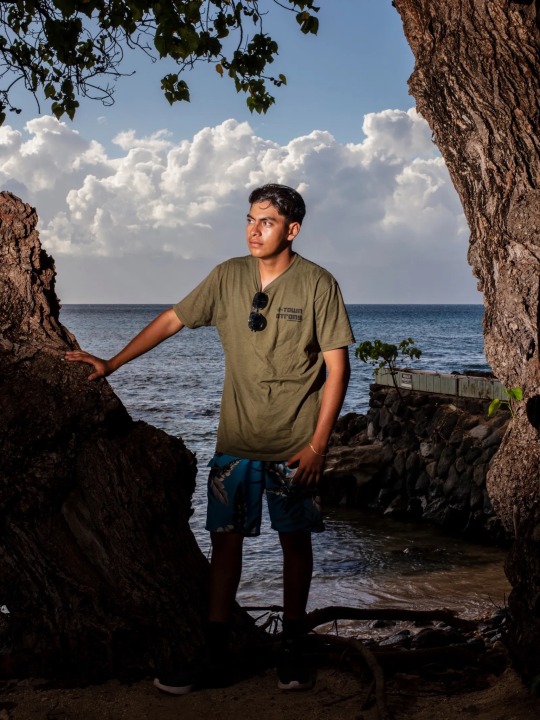
Three children died in the Lahaina fire. Josue Garcia Vargas, pictured above, lost his brother, fourteen-year-old Keyiro Fuentes, who was at home, asleep with the family dog, when the blaze swept onto the street.
That stream is not connected to the county’s water network, which supplies Lahaina’s fire-hydrant system. Moreover, the day’s heavy winds meant that helicopters could not use those reservoirs to fill water bombs (known as Bambi Buckets)—they could not fly at all. Still, many were eager to blame the Native Hawaiian water deputy and, by extension, the water code. (A headline in the New York Post read, “Hawaii official concerned with ‘equity’ delayed releasing water for more than 5 hours as wildfires raged.”) Manuel was reassigned to another department.
Peter Martin, West Maui Land’s co-founder and C.E.O., told me that protecting water for Native Hawaiian cultural practices was “a crock of shit,” and that invasive grasses and “this stupid climate-change thing” had “nothing to do with the fire.” He felt unfairly demonized by activists: “They’re trying to paint this picture that I’m a colonialist.” The real problem, he said, was the water commission and its code, which was so overbearing that it prevented him from replacing dry grassland with irrigated, landscaped parcels, or even small hobby farms. Maui’s lands, he added, “weren’t being used as God intended.”
Sixteen Days After the Fire, Maui County, with help from the F.B.I., released a list of three hundred and eighty-eight missing people. This was a distillation of a larger list, with more than a thousand names, that had been assembled from potentially unreliable sources—online groups, anonymous calls—and contained redundancies and errors. (Many individuals had the strange experience of seeing the list and learning that the F.B.I. thought they were missing.) The estimated death toll had remained the same since August 21st, when the police announced that they had recovered a hundred and fifteen bodies.
Two blocks from Saribay’s house, Alfredo Galinato, a seventy-nine-year-old Filipino immigrant, had lived with his wife, Virginia, and their son James, who is mentally disabled. When the fire approached, Galinato told James to run to Safeway, where Virginia worked. Then Galinato climbed onto his roof with a hose to soak the house, just as he had done during previous fires. Virginia and James survived, but Galinato was now among the missing. His two other sons, Joshua and John, who were not in Lahaina on August 8th, went to the burn zone to look for their father. “Everything was burned to dust,” Joshua told me. After searching for seventy-two hours, they heard that authorities were collecting DNA samples from people with missing relatives, and they went to a community center to get their cheeks swabbed.
Following the fire, forensic anthropologists, dentists, pathologists, and fingerprint and X-ray technicians flew to Maui, to aid the overwhelmed coroner’s office. Urban search-and-rescue teams, deployed by fema, started working with cadaver dogs across the five and a half square miles that had burned.
The Lahaina fire reached temperatures more than a thousand degrees hotter than the temperature on Venus. Four thousand vehicles were caught in the flames, and almost none of them were left with tire rims. “There were rivers of melted aluminum down the streets,” Stephen Bjune, the spokesperson for fema’s Urban Search and Rescue Team, told me. But the fire also moved in mysterious ways. A truck on Front Street had been full of glass bottles for recycling, all of which melted. Five feet away, a single silver minivan was unmarred, as if it were still sitting in traffic.
It was so hot in the burn zone that the dogs could work only in quarter-hour shifts. About fifteen per cent of the discovered remains were intact enough to obtain fingerprints from—that is generally the quickest route to identification. In another thirteen per cent, forensic dentists were able to identify people from their teeth. In two per cent, medical hardware—such as a pacemaker—was used to make identifications. But, for about seventy per cent of the victims, the experts needed DNA. In the majority of those cases, there were still significant amounts of tissue. In a few cases—the most difficult ones—there were only ashes and small fragments of bone.
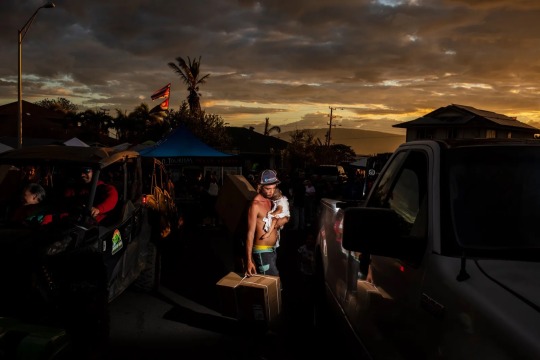
A resident picks up an air purifier from outside Archie Kalepa’s house, in Leiali‘i. Within forty-eight hours of the fire, the house had become one of Maui’s first community-organized emergency hubs.
The DNA analysis was conducted with the help of ande Rapid DNA, a biotech and public-safety company. ande manufactures a hundred-pound printer-size instrument that can generate a DNA profile, or “fingerprint,” in two hours. It can analyze five samples at a time—drops of blood, pinhead-size bits of liver, or fragments of bone. Richard Selden, the company’s founder and chief scientific officer, said that he and his team initially developed the instrument for the United States military’s counterterrorism operations in the Middle East, so it was designed to be portable and rugged.
The DNA fingerprints were compared with reference samples that families, like the Galinato brothers, had provided. The problem was that many family members were not submitting samples. Some authorities attributed this to a lack of trust between residents and the government, which went back more than a century, to colonization. Officials launched a publicity campaign emphasizing that the DNA samples would be used only by ande, and would not be used by the government for tracking people.
Alfredo Galinato was one of the first victims to be identified using the rapid-DNA machine. He had worked as a groundsman at the Westin, near Lahaina, for twenty-five years, and loved taking care of the hotel’s parrots. I met his family across the island, at the house of his son John’s fiancée, about a week after they received confirmation of his death. John, a carpenter, looked just like his father—with a gentle, open face and the strong, scrappy build of a former high-school state wrestling champion. He said that he felt blessed to have found out about his dad relatively quickly, compared with all those who were still searching.
Later, as I was driving back to Lahaina, John sent me a text, written as if his father were still alive. “Idk if I mentioned. My dad is a hard working man, dependable,” he wrote. “I can count on him.”
A Strange Scale of Tragedy had developed on Maui. Those who hadn’t lost loved ones might still have lost everything they owned. And yet some said they felt lucky. “Just material things,” one person told me. A woman named Michele Pigott, who had lived in Lahaina since 2011, said that this was the third house she had lost to a fire. (The first two were in California.) She was almost immune to being displaced again. “Piece of cake,” she told me. “There’s not a goddam thing you can do.”
But anger was pulsing under the surface. As one mother said to me of the disaster response, “How could so many people fail at their job at the same time?” Among the first failures were the warning sirens. Although Maui has eighty of them, none were activated when the fire began. A week after the disaster, Herman Andaya, the administrator of the Maui Emergency Management Agency, defended his decision not to use the sirens, saying that they were primarily for tsunamis—even though the agency’s Web site lists brush fires as one of the reasons for the “all-hazard siren system” to go off. Andaya said he had been concerned that the sirens would send people fleeing to higher ground, into the flames. He also said he was afraid that people wouldn’t even hear the sirens, because almost all of them are along the coastline, and that he did not regret his decision. The following day he resigned, citing health reasons.
Another problem was the lack of firefighters. The Maui Fire Department has long been short-staffed and underfunded. Despite the vast increase in wildfire country on the island, the last time a new station was built was in 2003. West Maui’s population has grown from roughly eighteen thousand to twenty-eight thousand over that span, and is serviced by two stations and three trucks. No more than sixteen firefighters were initially on duty in Lahaina on the afternoon of August 8th. “They did an extraordinary job,” Bobby Lee, the president of the Hawaii Fire Fighters Association, told me—“before they ran out of water.” County water levels were already low, and then the fire hydrants lost too much pressure. Some ran dry. The fire’s extreme heat had caused water lines to break, something that also happened in a catastrophic urban fire in Fort McMurray, Canada, in 2016.
Many survivors have said that they received no evacuation orders from the police. When Mayor Bissen was later asked why, he said that, in fact, police officers had driven the streets, calling from loudspeakers. But that had happened later in the evening, near where fires were still burning on Lahaina’s north end. After a local reporter pressed him on the failure, Bissen said, “You can decide what the reason was, whether it was somebody did something on purpose, or somebody did something out of negligence, or somebody did something out of necessity. There are probably a lot of reasons you can apply to why we do what we do as human beings.”
I asked the Maui County police chief, John Pelletier, about all the roads out of Lahaina that had been closed. He said, “There was always a way out, if people were willing to go that way. Nobody was barred from going out of Lahaina town.” He continued, “We were encouraging everybody to get out, but it just depends on the dynamic. It may not have been the way that they maybe wanted to go.”
The nature of the disaster, and the chaos and information void in the aftermath, lent itself to rumor and conspiracy theories. Selden, the ande scientist, told me that there are two kinds of disasters: open and closed. A plane crash is the latter—there is one site of wreckage and a manifest listing who was on board. Lahaina is open. There is no list of people who were in town that day, and the burn area is large and unfixed. Speculation about the demographics of the victims was rampant. Because school was not starting until August 9th, people thought a lot of children might have been home. As of late August, only two families had reported the loss of a child; the police had not confirmed their deaths or identities.
Keyiro Fuentes, who was fourteen years old, was at home, asleep with the family dog, when the fire swept onto his street. His mother came back from work to get him, but the police blocked her, saying that they had already cleared the area. Days later, the family found Fuentes’s body in the house. His father wrapped the body in a tarp and, with his older son’s help, drove Fuentes to a police station. “ The first thing I said was, ‘Mr. Officer, I have a body and it’s that of my little brother,’ ” Josue Garcia Vargas, Fuentes’s twenty-year-old brother, recalled. One officer at the station seemed to be in shock. “His hands were shaking,” Vargas said. “I kept telling him the name, and he kept saying, ‘What? What?’ ”
In mid-September, the police confirmed Fuentes’s death. The identification was delayed because Fuentes was adopted, and the police had to obtain DNA samples from his biological family, in Mexico, to confirm that he was who the Vargas family said he was. But the Vargases had already held a memorial. A week after the fire, when Fuentes would have turned fifteen, his mother threw him a birthday party.
Months earlier, Fuentes had told Vargas about a girl he had a crush on in his class. She hadn’t seemed interested, so Vargas suggested that Fuentes flirt with the girl’s cousin to make her jealous. Both girls had attended the memorial. “They were both crying, man,” Vargas told me when we met, tears rolling down his face, although he was smiling. “He made them cry. That made me happy.” Fuentes had been a tough, fiery, and sweet little kid, who loved mixed martial arts. “He wanted to be a police officer,” Vargas reminisced. “He saw when my mom got screamed at by one of our neighbors and he got mad and said, ‘I’m going to be an officer so this will never happen to you.’ ”
When the family had found Fuentes, Vargas added, their dog’s remains were there, too. “We think they were hugging each other,” he said, now hugging himself, struggling to speak. He reminisced, of his brother, “He was always there, making his presence known, saying ‘Wassup, bro!’ ” He paused. “It’s hard for me to accept the reality of what happened.”
On August 29th, Pelletier announced that recovery crews had completed ninety-nine per cent of their land search in Lahaina. More than three hundred people remained unaccounted for, but the estimated number of deaths had not changed. The Galinatos’ neighbor, a forty-three-year-old E.M.T. named Tony Simpson, was still missing. The day of the fire, Simpson’s parents were at home in Belize, his sister Nichol was in Thailand, his other sister, Nova, was in Connecticut, and his brother was in New York. After a couple of days, none of them had heard from Simpson, an they started to panic. They made dozens of calls—to his employer, to the Red Cross, to the F.B.I., to the police. Nichol posted Simpson’s photo in a Maui-disaster-relief Facebook group. Nova filed a missing-persons report and submitted a DNA sample to an F.B.I. office in Connecticut.
The family had agreed that it made sense to do what they could from a distance, rather than get in the way of the authorities. But, after two weeks, Nichol and her husband, Angel Priest, made the forty-hour journey from Thailand to Maui. Their first stop was the Family Assistance Center, which was housed in a Hyatt Regency hotel. The complex was full of displaced people wandering a maze of courtyards, shuttered shops, and gardens. Nichol sat to give a DNA sample; ande had an instrument on-site. She asked if her sister Nova’s DNA was already in their system. The workers didn’t know.
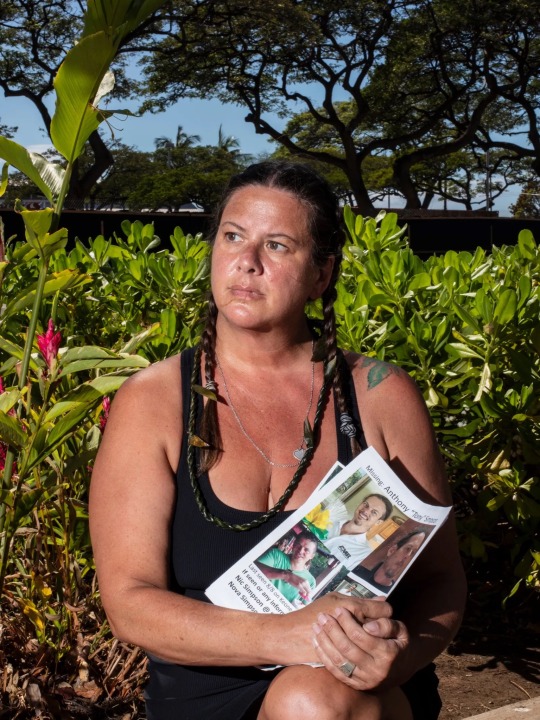
Nichol Simpson, holding a missing-persons flyer for her brother Tony, who was unaccounted for in the weeks after the fire.
Nichol soon learned that a large percentage of victims were recovered within a few blocks of Simpson’s home. When she told other families on the island where her brother lived, they’d offer condolences. Nichol tried to visit Simpson’s house in the burn zone but was stopped by the National Guard and told she needed an official escort. She called the police, and a receptionist suggested that she call the E.O.C. When Nichol asked what the E.O.C. was, the receptionist didn’t know. (E.O.C. is the Emergency Operations Center.) Nichol reached a person at the E.O.C., but learned that she could not, in fact, get an official escort into the burn zone. She was also told, by a field worker, that the residential area had been fully searched. That is, except for multistory buildings. This only confused her more. Simpson’s house was two stories. Had it been searched? Unclear.
Nichol and Priest talked to unsheltered people in encampments. Simpson had a strong tie to that community; he had moved to Maui with a friend who chose to live outside. “We’re literally stopping people on the street and asking them, ‘Do you live here? Can you help us find a place to go search?’ ” Nichol told me. “Tomorrow we’re going to find some random cave somebody suggested.” I asked if they really believed that Simpson was hiding out somewhere. “Absolutely,” Nichol said. Simpson had led an eclectic life. He lived off the grid for two years, “on mangoes, basically, like a friggin’ fruitarian.” She added, “We could just see him showing up later with some crazy story.” Like he’d been living in a cave for two weeks. “Maybe he can make a big Hollywood movie about it,” she said, letting out a belly laugh. “Actually, he would hate that.”
After ten days, Nichol and Priest decided to fly to Belize to be with her parents. Before they left, they drove to the Lahaina post office to get Simpson’s mail forwarded to them. “We were really grasping at straws for small things that I could take back to my family,” she told me. “Because we have nothing of his.” This was true of many victims’ families. The Galinatos had lost most of Alfredo’s belongings, although his wedding ring had been recovered by search-and-rescue workers.
On the way to the post office, Nichol received a call from the Maui P.D. The police had matched her DNA with her brother’s remains, which they had found on August 11th—twenty-one days earlier—in a burned structure near his house, along with the remains of several others. As people had sought shelter, they landed in others’ homes, businesses, or cars, and in some cases died together. The location and commingling of remains delayed the processing of samples, and comparisons with the families’ DNA. This situation also resulted in an initial overcount of victims; two different body bags might later have been found to contain one person.
Nichol was not only heartbroken by her brother’s death but frustrated by the lack of clear communication from the authorities. “We’re thinking, They’ve recovered a hundred and fifteen bodies. They’ve recovered no more in several weeks. We don’t match any of those bodies, so Tony must still be missing,” she told me. “It brought us a lot of false hope.”
The Morning After the Fire, when Saribay was leaving the church parking lot, he saw smoke in the direction of a house belonging to his kids’ grandparents, in a neighborhood called Leiali‘i. He drove there and found his brother, who told him that another house, bordering their friend Archie Kalepa’s property, was smoldering. The fire department had already been there, but the fire had flared back up.
Saribay and his brother ran across neighbors’ gardens, grabbing more hoses. They broke Kalepa’s fence and soaked his yard. Saribay’s shirt had melted the night before, but he’d found a backpack containing women’s clothes that he had changed into. Saribay has a mischievous streak, which, despite what he had been through, hadn’t gone away. “I fucking fought that motherfucker while I was in a red fuckin’ blouse,” he said.
They extinguished the fire. Leiali‘i had been built seventeen years ago, as part of the Hawaiian Homes Commission Act, which allots homesteads to people who have at least fifty per cent Hawaiian blood. And the neighborhood was saved. Of its hundred and four houses, only two burned down. “At 10:30 p.m., when I evacuated, the flames were as high as the trees right behind my house. I thought it’d be gone,” Rodney Pa‘ahana, the president of the Leiali‘i Association, a community group, told me. “We were astounded,” he continued. “God put a finger on us, as if to say, The Hawaiian people need to stay and rebuild.”
Kalepa had been in California during the fire, but he came home on the first flight he could. When he arrived, Saribay apologized for breaking his fence. “Fuck my fence!” Kalepa told him. “You’re the guy who saved my house!” Within forty-eight hours, that house became one of Maui’s first community-organized emergency hubs. Kalepa told me that the donations, which ranged from money to food and supplies, had been overwhelming. People were sending poi—a traditional Hawaiian staple consisting of paste made from ground taro—from four islands away. Lahaina residents started calling the house “the local Costco.”
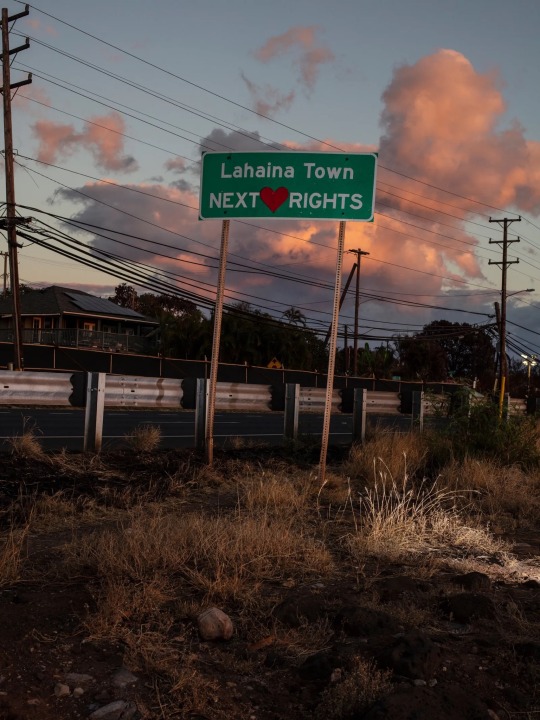
The cost to rebuild Lahaina will be an estimated five and a half billion dollars.

“We have one chance of fixing this,” Archie Kalepa said, of the rebuilding process. “And, if we get it wrong, all of Hawaii’s going to fail. Not just Lahaina.”
I met Kalepa on the cul-de-sac outside his house in late August, under a cluster of pop-up tents. There were more than two dozen coolers, towers of water bottles, Clorox wipes, a bleeping Starlink router (for Internet), and a machine that converted moisture from the air into water. Friends and volunteers were lugging boxes and ice, setting up rooftop solar panels, and peeling bananas to make banana bread.
Kalepa asked if I wanted to see the line where Saribay had held off the fire, gesturing toward the back yard. It all seemed fairly normal. But at the edge—beyond the grass, palm fans, magenta stalks, and yellow frangipani flowers with pink centers—there was a gap where the fence had been. On the other side of that gap, the world was suddenly black-and-white. A foundation of scorched cinder blocks suggested the ghost of a house. Rusted rebar poked the air. There was a shovel, bent like a bow tie. A hollowed pickup truck was snapped in half. The air was stagnant with the lingering, acrid smell of smoke, rot, and death.
Kalepa, a ninth-generation Hawaiian, recently turned sixty. He is a former lifeguard and big-wave surfer who provides ocean training to Navy seals. In the weeks since the fire, he has become one of Maui’s most prominent community leaders. “I never wanted to be in this position,” he told me. “I was really enjoying my life.” He is now serving on Mayor Bissen’s five-member Lahaina Advisory Team, which will consult on the town’s rebuilding. “We have one chance at fixing this,” Kalepa said. “And, if we get it wrong, all of Hawaii’s going to fail. Not just Lahaina.” One of the community’s biggest fears is that the process will favor developers, tourists, and the wealthy. Kalepa, other activists, and water-rights groups have been strenuously advocating for the local community. On September 8th, Governor Green announced that he was reinstating the state’s water code. Several weeks later, the water deputy, M. Kaleo Manuel, was returned to his post.
An organization called the Fire Safety Research Institute has been selected to investigate the government’s response to the catastrophe. Initial findings are expected by December. But responsibility for the fire falls in many places, on many individuals, across the decades. “For the last hundred and fifty years,” Kalepa said, “Hawaii’s gone in the wrong direction. This situation we’re in right now? It brought that to light.”
People Often View disaster survivors’ stories as they would an apocalypse film—a frightening but faraway and anomalous event, witnessed from a safe place. But these stories are missives from our immediate future—postcards from what, one day, might be your circumstance, in this era that some climate-change experts now call the Pyrocene. Record-breaking wildfires are happening more frequently all over the world, with studies directly linking climate change to the increase in fire duration, size, and severity. Wildfires in the U.S. caused more than eighty billion dollars in damage from 2017 to 2021, a nearly tenfold increase from the previous five years.
Hawaii has made gestures at addressing climate change; in 2015, it was the first state to pledge to convert entirely to renewable energy by 2045. And yet critics have jumped to blame the power company, Hawaiian Electric, for focussing on renewables, claiming that it was doing so at the expense of maintenance that could have prevented the West Maui fire. Similar debates are playing out all over the country, where the same funds required for infrastructure maintenance and improvements, in this hot new world, are also needed for the green-energy transition.
Hawaiian Electric’s C.E.O., Shelee Kimura, testified at a congressional hearing that thousands of aging utility poles had not been tested for termites or rot since 2013, but she also said that power lines had been de-energized for more than six hours before the afternoon fire began, and that the company was therefore not responsible. Her assertion, and the fire’s true cause of ignition, are under investigation, and the company now faces more than a dozen lawsuits, including one filed by Maui County.
On October 8th, the two-month anniversary of the fire, Governor Green welcomed tourists back to parts of West Maui. Many community members were outraged; they felt that they weren’t near ready. Just a few days later, more human remains were found in Lahaina. Six people are still missing, and there is one body that has not yet been identified. “Imagine what happens when you gotta live in temporary housing, surrounded by ash, and go to work back in those hotels,” Nā‘ālehu Anthony, a filmmaker and an activist, told me. “People just hit this wall where they’re saying, ‘We’re not going to do that anymore.’ ”
Even though returning to work was hard to stomach, it was crucial to Maui’s economy, which is heavily reliant on tourism, and necessary for residents, who were struggling with bills and insurance. Many residents were worried about their mortgage payments, which are still due even after your house burns down. “For what, a piece of dirt?” Saribay said. His kids were O.K., which was “all that matters,” he said, but he had lost three of his houses, his tattoo parlor, and his boat. He was living in his kids’ grandparents’ house in Leiali‘i. Saribay told me that he had taken a forty-hour course to obtain a hazmat certification, so that he could be part of the effort to clear the rubble from Lahaina. But the idea had become a nightmare. “I just don’t want to be in there right now,” he said.
“Fifty to sixty per cent of the people that passed away was from my neighborhood,” Saribay told me. He has been dealing with trauma: “My nights are a fucking question mark,” he said. “I’m so tired. My mind races.” He has thought about leaving Hawaii altogether, and has felt financial pressure to sell his land—a common experience among homeowners, some of whom reported receiving calls from real-estate investors just days after the fire. “I could just be outta here and say, ‘Fuck Hawaii,’ ” Saribay continued. “I’m not gonna, but fuck.”
He has had delays with his fema relief application—he still doesn’t know how much money or what kind of housing assistance he will get.“Everything will be O.K. if the government really helps us, but they’re not,” he said. “It’s the people of Maui who’s helping each other.”
One Friday evening, I attended a community meeting at Kalepa’s house, which had become a weekly event. People offered advice, consolation, ideas. One man discussed new air purifiers that had been donated by a nonprofit, which residents could take home with them. Pa‘ahana, the Leiali‘i Association president, gave a teary speech arguing that Lahaina should be rebuilt as a giant beach park, with all the shops and homes staying up near the highway. “I know I’m gonna get a lot of flak from the billionaires and businesses,” he said. “But, if we do this right, they will thank us when we’re not here anymore.” As he spoke, fat raindrops started falling. Kalepa told the crowd, “The blessings are pouring out for us.”
Many Hawaiians want to make this moment an opportunity. “It’s very rare to have people plan a new town after hundreds of years of history,” Pa‘ahana told me. “But we get a chance.” The tropical shower stopped as suddenly as it had started. A line of volunteers carried platters of opakapaka, venison, coconut, and poi to folding tables set up in the cul-de-sac. Saribay was bopping around, taking pictures of the food and cracking jokes. “He’s so full of life,” Kalepa said, grinning in his friend’s direction. As it got dark, kids sat on the asphalt playing duck-duck-goose. Anthony, the filmmaker, told me, “The reason Archie Kalepa stood this up is because his community needed help, and because the idea of aloha is not how much you can keep. It’s how much you can give away.”
The first week and a half after the fire, apart from the machinery and the dogs, Lahaina was silent. No birds or bugs were alive. But even among the ashes there is virescence. The oldest banyan tree in Lahaina, planted a century and a half ago, beaten and blackened by fire, has sprouted green buds. They appear to glow against the surrounding moonscape, like time travellers from our once and future planet. ♦
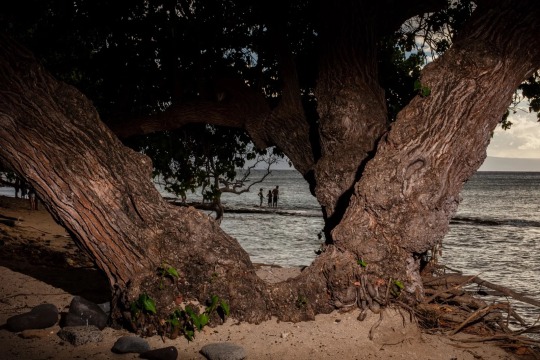
“Everything will be O.K. if the government really helps us, but they’re not,” Saribay said. “It’s the people of Maui who’s helping each other.”
0 notes
Link
After Fukushima, balancing the risk of another disaster against the rising danger of climate change.
Carolyn Kormann | New Yorker | Dec 2019
5 notes
·
View notes
Quote
In Sean Sherman’s modern Indigenous kitchen, every dish is made without wheat flour, dairy, cane sugar, black pepper, or any other ingredient introduced to the continent after Europeans arrived.
Carolyn Kormann on Owamni, in Minneapolis
0 notes
Text
Evolution & Effect of a Coronavirus
Evolution & Effect of a Coronavirus
From Bats to Human Lungs, the Evolution of a Coronavirus By Carolyn Kormann March 27, 2020 Illustrations by Laura Edelbacher; Animation by Patryk Senwicki For thousands of years, a parasite with no name lived happily among horseshoe bats in southern China. The bats had evolved to the point that they did not notice; they went about their nightly flights unbothered. One day, the…

View On WordPress
0 notes
Photo

Yarasalardan insan ciğerlerine korona virüsünün evrimi Carolyn Kormann Ismi bile olmayan bir parazit, binlerce yıl boyunca Güney Çin’deki at nalı yarasaları arasında keyifli biçimde yaşadı.
0 notes
Photo

#COVID19 #covid19Canada "From Bats to Human Lungs, The Evolution of A Corona Virus", by Carolyn Kormann, 27 Mar,'20 @nytimes https://t.co/KUTmWhqTvT 2PLAN22 http://twitter.com/2PLAN22/status/1243919179859791872
#COVID19#covid19Canada "From Bats to Human Lungs, The Evolution of A Corona Virus", by Carolyn Kormann, 27 Mar,'20 @nytimeshttps://t.co/KUTmWhqTvT
— Plan22 Archibrarians (@2PLAN22) March 28, 2020
0 notes
Text
Bibliography
« 20th-Century Warming “unmatched” in 2,000 Years ». Consulté le 11 février 2020. https://news.yahoo.com/20th-century-warming-unmatched-2-000-years-193608775.html.
Atkin, Emily. « The Power and Peril of “Climate Disaster Porn” ». The New Republic, 10 juillet 2017. https://newrepublic.com/article/143788/power-peril-climate-disaster-porn.
Bendell, Jem, Neil Sutherland, et Richard Little. « Beyond unsustainable leadership: critical social theory for sustainable leadership ». Sustainability Accounting, Management and Policy Journal 8, no 4 (1 janvier 2017): 418‑44. https://doi.org/10.1108/SAMPJ-08-2016-0048.
Brand, Fridolin, et Kurt Jax. « Focusing the Meaning(s) of Resilience: Resilience as a Descriptive Concept and a Boundary Object ». Ecology and Society 12, no 1 (5 juin 2007). https://doi.org/10.5751/ES-02029-120123.
Clement, Megan. « I Followed the Advice for Paris’s Hottest Day – It Didn’t Help | Megan Clement ». The Guardian, 31 juillet 2019, sect. Cities. https://www.theguardian.com/cities/2019/jul/31/i-followed-the-advice-for-paris-hottest-day-it-didnt-help.
Clouse, Carey. Farming Cuba: urban farming from the ground up. First edition. New York, New York: Princeton Architectural Press, 2014.
Figueres, Christiana, et Tom Rivett-Carnac. « ‘Air Is Cleaner than before the Industrial Revolution’: A Best Case Scenario for the Climate in 2050 ». The Observer, 15 février 2020, sect. Environment. https://www.theguardian.com/environment/2020/feb/15/best-case-scenario-2050-climate-crisis-future-we-choose-christiana-figueres-tom-rivett-carnac.
Fleming, Amy. « The Case for ... Making Low-Tech “dumb” Cities Instead of “Smart” Ones ». The Guardian, 15 janvier 2020, sect. Cities. https://www.theguardian.com/cities/2020/jan/15/the-case-for-making-low-tech-dumb-cities-instead-of-smart-ones?page=with%3Aimg-3.
op.AL / op Architecture Landscape. « Forestation Urbanism ». Consulté le 17 février 2020. http://www.op-al.com/forestationurbanism-land.
Gheorghe Crutzescu. Podul Mogoșoaiei. Povestea unei străzi. Bucharest: Humanitas, 2014.
Ghosh, Amitav. « Amitav Ghosh: Where Is the Fiction about Climate Change? » The Guardian, 28 octobre 2016, sect. Books. https://www.theguardian.com/books/2016/oct/28/amitav-ghosh-where-is-the-fiction-about-climate-change-.
Hakim Bey. TAZ: The Temporary Autonomous Zone. Seattle, WA: Pacific Publishing Studio, 2011.
Kormann, Carolyn. « Rem Koolhaas’s Journey to the Countryside ». The New Yorker. Consulté le 12 mars 2020. https://www.newyorker.com/news/annals-of-a-warming-planet/rem-koolhaass-journey-to-the-countryside.
P. m. Bolo’bolo. New York; London: Autonomedia ; Turnaround [distributor, 2012.
PressOne. « România în 2050: portocale de Teleorman, tornade și câmpuri de ambrozie ». Consulté le 16 février 2020. https://pressone.ro/romania-in-2050-portocale-de-teleorman-tornade-si-campuri-de-ambrozie.
Servigne, Pablo, Raphaël Stevens, et Yves Cochet. Comment tout peut s’effondrer: petit manuel de collapsologie à l’usage des générations présentes. Paris: Éditions du Seuil, 2015.
Tsing, Anna Lowenhaupt. The mushroom at the end of the world: on the possibility of life in capitalist ruins. Princeton: Princeton University Press, 2015.
Wallace-Wells, David. « Climate Scientist James Hansen: ‘The Planet Could Become Ungovernable’ ». Intelligencer, 12 juillet 2017. https://nymag.com/intelligencer/2017/07/scientist-jim-hansen-the-planet-could-become-ungovernable.html.
———. « ‘The Models Are Too Conservative’: A Paleontologist on Climate Change Today ». Intelligencer, 10 juillet 2017. https://nymag.com/intelligencer/2017/07/what-mass-extinctions-teach-us-about-climate-change-today.html.
———. « When Will the Planet Be Too Hot for Humans? Much, Much Sooner Than You Imagine. » Intelligencer, 9 juillet 2017. https://nymag.com/intelligencer/2017/07/climate-change-earth-too-hot-for-humans.html.
Wohlleben, Peter. The Hidden Life of Trees: What They Feel, How They Communicate#x97; : Discoveries from a Secret World, 2016.
0 notes
Photo
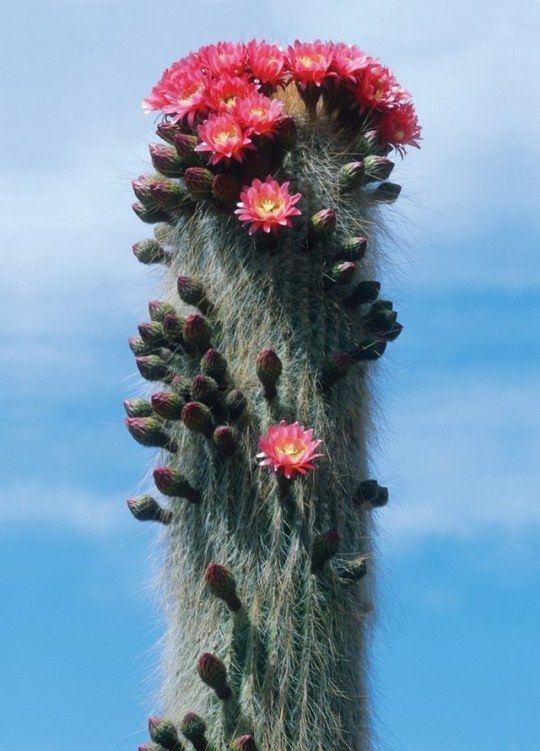
The Strange Wonders of the Cactus, the Plant of Our Times
By Carolyn Kormann
“ But perhaps it’s fitting that cactuses and succulents are today’s botanical vogue. They represent what people crave and aspire to, as climate change advances and democratic institutions retreat: they can survive the harshest weather and the bleakest landscapes. They are both irreverent and dignified. They are strong and resilient, and will endure for centuries, even millennia. “
#xerophile#cacti#cactus shop#hotcactus#los angeles#hat and beard press#cactus photographs#hot book alert#echo park
11 notes
·
View notes
Text
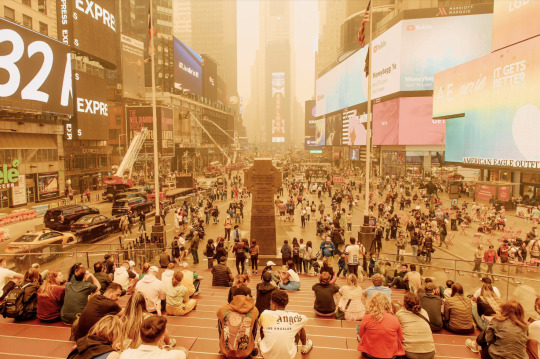
Photographs by Clark Hodgin for The New Yorker
Trying to Breathe in a City of Smoke
As the world warms and Canada burns, what once seemed unprecedented is becoming familiar.
— By Carolyn Kormann | June 7, 2023
When the smoke comes, you notice it in your body before you see it in the air. On Monday evening, I went for a run and then felt queasy and lethargic. Only on Tuesday did I notice the haze in Manhattan. By Tuesday night, the air smelled like barbecue. On the half-mile walk to my yoga studio, I saw a few people in N95 masks, and I wished I had worn mine. I started to get nauseated; my eyes felt itchy. A young man on the street cried out, “Those Canadian wildfires are sick, bro!” Online, someone tweeted about the “Blade Runner-ass weather.” I half expected the neighborly camaraderie that arises during intense storms and lunar eclipses, but mostly people just squinted and carried on. I worried about Frannie, my ninety-six-year-old landlady, who had walked four blocks to a neighborhood restaurant and back. She told me that she didn’t notice the smoke.
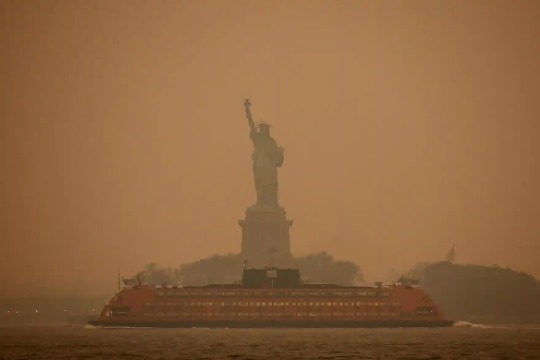
By Wednesday morning, ash was falling in northern New York. School trips and soccer games were cancelled. A friend texted, “Are you going to go outside and take a few drags off the sky?” I heard of a woman sitting on her front steps, struggling to breathe even with the help of oxygen. Friends of friends were reminded of places like Delhi, where daily exposure to severe air pollution can be deadly. New York City recorded the worst air pollution of any major city in the world, according to the company IQAir, and it was still getting worse. Just after noon, the magnolia and tulip trees outside my window shook violently in the wind. As weather forecasters had promised, a wall of smoke blew into Manhattan. At a Broadway matinée, the actress Jodie Comer said that she couldn’t breathe and left the stage.
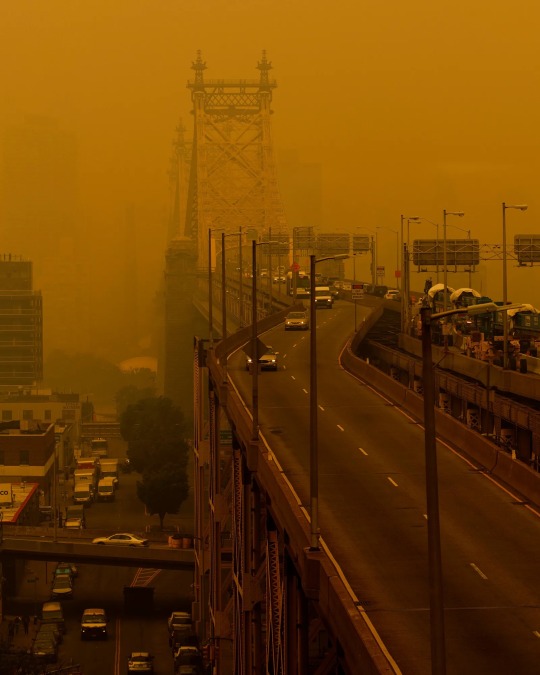
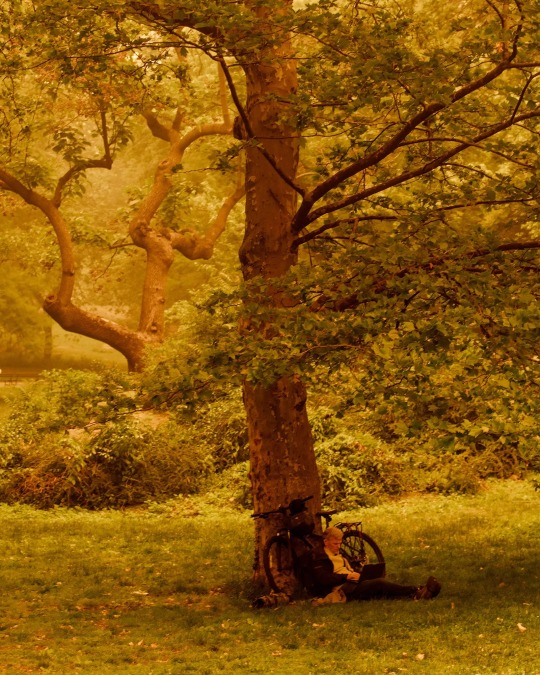
The smoke was coming from Canada, where more than four hundred wildfires are currently burning. We do not know what caused many of them—a dropped cigarette, lightning, a downed electrical wire—but they are raging through the boreal forests of British Columbia, Alberta, and now Quebec. Wildfires are nothing new in these woodlands, but these are much earlier and larger than usual. And, like so many recent fires, they are directly linked to weeks of anomalous extreme heat. Climate change has created longer, hotter summers; worsened droughts; and fuelled vast bark-beetle infestations that have killed billions of trees.
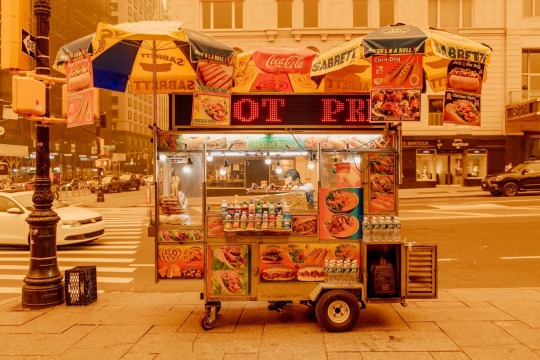
We keep experiencing things that are unprecedented, worse than anything anyone can remember, even as we’re told that they will become common. “You’re likely to see events like this more often, where you have prolonged heat that dries out forests and makes these fires more likely,” Marshall Burke, a professor at Stanford University, and a leading expert on wildfire-smoke exposure and impacts, told me. Burke has plotted the levels of fine particles, which scientists call PM2.5 because they are 2.5 microns or smaller, in the past seventeen years of New York City air. The past two days, he said, have been off the charts. But even these levels didn’t reach what West Coast cities, including San Francisco and Seattle, have experienced in the past few years.
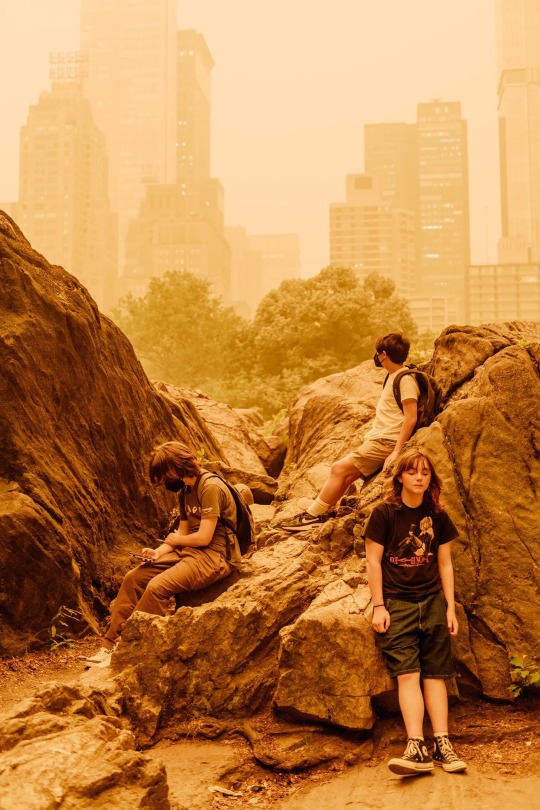
“There is no safe exposure to PM2.5,” Burke told me. In the past decade, research has shown that these particles can penetrate deep into the lungs, enter the bloodstream, and even reach the brain. They are associated with heart attacks and dementia. Even among healthy people, Burke and his team have found that, with higher levels of air pollution, cognitive performance decreases, and workers are less productive. There is a very strong relationship between even just short-term smoke exposure and poor pregnancy outcomes—in particular, preterm birth. Research by Burke and his collaborators has concluded that, when there are fifty micrograms per cubic metre of PM2.5 in the air, emergency-department visits for asthma tend to double. Burke checked New York’s numbers at that moment, around 1 p.m., and saw that they had reached about a hundred and fifty micrograms. “That’s just crazy,” Burke told me.

I told Burke that smoke had begun to seep into my office, like a deskside bonfire. “This is a really important point,” Burke said. “I mean, we can stay inside, but being inside is imperfect.” He pulled up a map of indoor air quality, which draws on data from citizen scientists who are publicly sharing measurements from their air monitors. “I’m just looking at Manhattan right now,” he told me. “I can see inside people’s homes, and they’re at sixty, or even above a hundred micrograms inside.” This is far above the threshold, outdoors, that would double emergency-room visits for asthma. In poorer communities, highways, power plants, and leaky buildings often make this problem persistent.

By one-thirty, the world through my window looked sepia. The sky turns orange because only longer wavelengths of light penetrate the smoke. Frannie, my elderly landlady, was now concerned. She has spent her life in New York and has never seen anything like this. She put on a mask inside; so did I. I worried about my sister, a teacher in Yonkers, who has bad asthma and felt light-headed and dizzy. “I’m feeling a little nervous and scared,” she told me in a voice mail. “I have students who are asthmatics, too. It’s really eerie to see how it’s bright yellow outside, and you can see the smoke sitting. Nothing that we’ve ever experienced here. Makes me feel more for those that experience this out West. Also, a good teaching opportunity.” She meant, quite literally, a science lesson about air-quality levels and their resulting health impacts. But what is it supposed to teach us? We know the story of the climate crisis, of how wealthy nations have burned fossil fuels at an astonishing rate, pushing our planet to the brink. Yet we live as though we do not, and we breathe the consequences. ♦
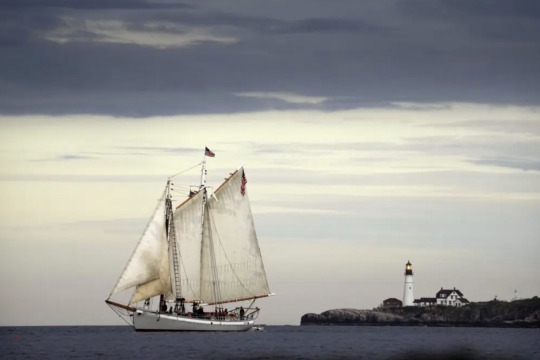
0 notes
Link
The New Yorker By Carolyn Kormann June 28, 2019 ---------------------------------- WHY DO THEY FEAR THE RALITY OF THE MESS THEY CREATE AND PERPETUATE?
0 notes
Text
Od šišmiša do ljudskih pluća: evolucija koronavirusa
Carolyn Kormann
Na hiljade godina bezimeni parazit sretno je obitavao među potkovastim šišmišima u južnoj Kini. Šišmiši su evoluirali do te mjere da ih nisu ni zamjećivali, neometano leteći po noći. Jednoga dana, tom parazitu, pretku koronavirusa, SARS-CoV-2, ukazala se prilika da proširi svoje carstvo. Možda je u pitanju bio pangolin, krljuštavi mravojed, ugrožena vrsta, žrtva neprestanog…
View On WordPress
0 notes
Text
The Changing Climate Inside the World's Largest Bat Colony - The New Yorker
The Changing Climate Inside the World's Largest Bat Colony The New Yorker
Carolyn Kormann writes about changes in the bat colony at Bracken Cave, in Texas, and about the threat that climate change poses to global biodiversity, even ...
Originally Published here: The Changing Climate Inside the World's Largest Bat Colony - The New Yorker
#Spliced Feed 3 (Johny Santo)#The Changing Climate Inside the World's Largest Bat Colony - The New Y
0 notes
Text
At the intersection of Beach Ninety-fourth Street and Rockaway Beach Boulevard, a Trump rally was under way. Winckler said no—that was a separate event, and they had ignored the scientists. As the afternoon passed and the rain picked up, the group, in “America First” and Trump 2020 T-shirts, continued chanting “U.S.A.!” and waving maga flags. Directly across the street, a group of counter-protesters had gathered, holding up signs like “Mermaids Against Misogyny” and “Rockaway Against Rape Culture.” On the maga side, a man with a blow horn began to sing “God Bless America.” The counter-protesters quickly joined in, singing at the top of their lungs. For a moment, the two groups seemed like one. Then the song ended, everyone cheered, and a cop yelled, “Play ball!”
"Ask a Scientist: How to Deal with a Climate-Change Skeptic" By Carolyn Kormann
0 notes
Text
A Disastrous Summer in the Arctic
Carolyn Kormann writes about record temperatures thawing permafrost across Siberia, resulting in greenhouse-gas emissions and dramatic destabilization of the land—which, in late May, helped cause the Russian Arctic’s largest ever oil spill. from Humor, Satire, and Cartoons https://ift.tt/31jOlU4 from Blogger https://ift.tt/3eCI0qw
0 notes
Photo
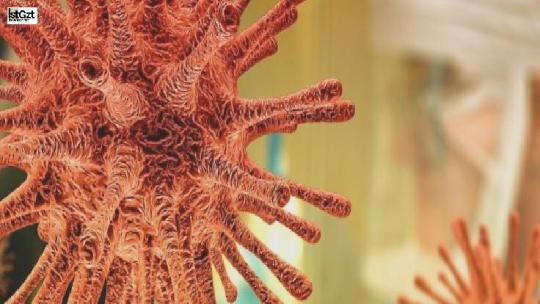
Yarasalardan insan ciğerlerine korona virüsünün evrimi Carolyn Kormann Ismi bile olmayan bir parazit, binlerce yıl boyunca Güney Çin’deki at nalı yarasaları arasında keyifli biçimde yaşadı.
0 notes
Text
The Teen-Agers Fighting for Climate Justice
The Teen-Agers Fighting for Climate Justice
Carolyn Kormann, The New Yorker “Climate change is the greatest threat of the twenty-first century,” an organizer of the youth climate march, on Saturday, said. “The way we live our lives is affecting people everywhere.”
View On WordPress
0 notes